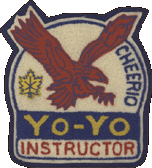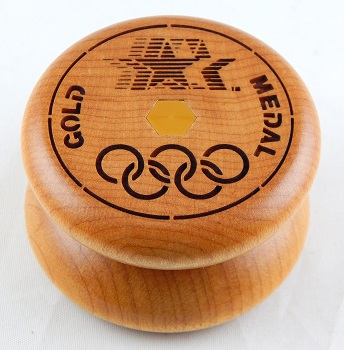                |
 |
 Sponsors and Curators Sponsors and Curators
The Museum of Yo-Yo History is a labor of love, and we would not be able to stay up-to-date with exhibits without the support of our sponsors and curators. Big thanks go to One Drop Design and Duncan for supplying us with their latest models, YoYoExpert for their help and support, and to Cody Orr, TotalArtist and YoYoBrothers™ for allowing us to use their collections!
If you're a manufacturer, or just a big collector and you want to help support the Museum drop me at line at chimera@yoyomuseum.com
|
 |
 |
 |
|
|
 |
| Tom Kuhn No Jive - 1984 Olympic Gold Medal (Model F) |
| Exhibit #3943 |
 |
 |
| Type | Prototype |
| Shape | Concave )-( |
| Axle | Fixed |
| Finish | Stained |
| Color | Maple |
| Construction | Three piece wood |
| Response | None |
| Diameter | 55mm |
| Width | 34mm |
| Gap | Fixed |
| Weight | 50 gm |
| Condition | Mint |
| Date | 1984 |
| Owner | Rick Brough |
| Compare |  |
|
|
A rare Tom Kuhn No Jive Olympics Gold Medal, Model F maple yo-yo prototype made for the 1984 summer Olympics in Los Angeles. (One of the few exceptions in this museum in which I use the adjective rare—an over-used word that has become meaningless thanks to eBay and social media—to accurately and precisely describe this yo-yo.) This maple yo-yo is in a Flying Camel shape and has a different laser engraving on each flat side.
Early Tom Kuhn No Jive yo-yo models were available in one of two shapes:
• Model C - Classic shape (also known as Traditional, Tournament, or Imperial shape).
• Model F - Flying Camel shape (also known as Bowtie or Butterfly shape).
Most of the dismantleable No Jive yo-yos that Tom sold in the early days of Tom Kuhn Yo-Yos were in a Model C shape.That is, they were sold in the traditional tournament shape with the laser engraving on the convex face of each halve. Even though you could buy a Model C and turn it into a Flying Camel (Model F) or a Pagoda Yo (also known as Piggyback) shape, most people left their yo-yo in its original configuration at the time they bought it. Interestingly -- though not surprising -- no Tom Kuhn yo-yo model was ever sold in the odd Pagoda Yo configuration.
There were three different Tom Kuhn prototypes made for the Games of the XXIII Olympiad (July 28 to August 12, 1984). The first two prototype models were the No Jive Model C Gold Medal yo-yo. Both had identical laser engravings on each side commemorating the games, and both were Classic configured. What differentiated these first two models were the hex nuts. One model used raw aluminum nuts and the other used aluminum nuts that were anodized a gold color. Everything else was identical. Most collectors are familiar with these first two prototype models.
The third model was the No Jive Model F Gold Medal yo-yo seen in this exhibit. In all my years of yo-yo collecting, I did not know about the existence of this third model until I saw it in Tom's personal collection, August 2015. This third model, in a Flying Camel configuration, used aluminum hex nuts that were anodized a gold color. As seen, the engraving is quite different from the first two models. There is no Tom Kuhn Custom Yo-Yos or © LA OOC 1984 engraving on either side. Furthermore, XXIIIrd was laser engraved as XXIIrd.
Up until now, it was mostly unknown to customers and yo-yo collectors that Tom and his employees were not permitted by the LA Olympic Organizing Committee to sell these Olympic-branded yo-yos. As such, all three prototypes were never considered an official release for retail by Tom Kuhn Yo-Yos. Read on to learn how some of these prototypes made it out into the wild over the years!
Recipe
Diameter: 55 mm
Weight: 50 grams
Width: 34 mm
Hex nuts: Anodized aluminum, gold color
Material: Maple - matte finish
Of interest...
To learn more about this uncommon No Jive model, I corresponded with Tom Kuhn several years ago:
TOM: Regarding the Olympic Yo-Yo, that Flying Camel version is a very rare bird. Here are details about it. At that time my wood turner was King Wood Turning [5370 Alhambra Avenue] in Los Angeles. It seemed appropriate to approach the 84 Olympic Committee and pitch an official Olympics Yo-Yo. The Olympics were headed by Peter Ueberroth -- who incidentally succeeded Bowie Kuhn (no relation) in 1984 as the sixth Commissioner of Baseball. Check out https://en.wikipedia.org/wiki/Peter_Ueberroth very interesting! So I made some calls to find out how to reach his office. Amazingly - I was actually connected with him! Excitedly, I gave him some background about this high quality, made in USA (LA) product that had been featured on national television. He gave me the contact person for official Olympic products, and I spoke with that department. They asked me how quickly could I get a prototype to them and they provided me with the official star and rings symbols to work with. Scrambled like crazy to come up with [the] design and sent them sample[s] of matte and glossy yo-yos -- if I recall correctly -- in about three weeks, along with literature about us. Waited to hear from them and made several calls. Eventually they decided not to include yo-yos in their official gear since it wasn't an Olympic sport. They also warned me not to market the product on my own. Hmmm. As far as the blue pouch story. The one that you have was hand made by my mother who lived in Florida. She made many of them for me in the 80’s out of velour material.
Rick: So the Flying Camel version was the prototype that you sent to the Olympic merchandisers for consideration and not the Classic configured Olympic?
TOM: I sent a glossy and matte Classic [Olympic yo-yo].
Rick: Was the Flying Camel version ever sold retail directly from you?
TOM: Very few because we weren’t supposed to sell them. Some people came around the yo-yo workshop one block from Haight and Ashbury when I was working at the dental office and some of the employees may have sold the few we had without my knowing it. In fact, I don't even have one like you have. My only Flying Camel [Olympic] version has the same "Gold Medal" and Olympic rings on both sides - no Games of the XXIIrd Olympiad like yours. My hex nuts are also not flat like yours, which is rarer. [Rick: The hex nuts on this model actually come to a raised tapered point; they're not flat-faced as Tom thought. By about 1981 or 1982, all No Jive models that came from Tom Kuhn were using raised tapered style hex nuts. The previously used flat-faced hex nuts went away by about 1980 or 1981. See the 1978 Tom Kuhn No Jive Flying Camel, Model C for an example of a flat-faced hex nut; specifically, see the Deep laser engraving picture in the exhibit).]
Rick: About the aluminum hex nuts… those were anodized a gold color, correct? They weren't brass as some have suggested? [Rick: For the record, TWO Tom Kuhn yo-yo models have been made with gold anodized aluminum nuts: The Tom Kuhn Classic-configured Olympic and the Tom Kuhn Flying Camel-configured Olympic. There was also a Tom Kuhn No Jive 1984 Olympic Gold Medal yo-yo in a Model C configuration with non-anodized, raw aluminum hex nuts, which is less common of the two.]
TOM: Correct. Aluminum.
Rick: I also noticed a couple of things. One is that the yo-yo did not have the "© LAOOC 1984" engraving as seen on the Classic configured Olympic. Was that a mistake or was it by design because it was a sample yo-yo for consideration by the merchandisers only?
TOM: It was a quick sample.
Rick: And the other things I noticed on this version is that the engraving "Games of the XXIIrd Olympiad" should have been engraved with "XXIIIrd" instead. Was that a mistake or by design?
TOM: Mistake; was corrected on the Classic.
Rick: Can you give a rough guess as to how many were actually made of the gloss and how many of the matte? Less than 10 each? Less than 20 each? More than that?
TOM: ??? A wild guess; Flying Camels 10, Classics 20-30 ???
Rick: The Classic configured Olympic yo-yo looked like that would have been the official release because it had "© LAOOC 1984" and "Tom Kuhn Custom Yo-Yos" engraved on it. Is that correct?
TOM: Yes.
Rick: I guess I'm trying to understand where the Flying Camel fits into the timeline of this series (the "why" of it). Was the Flying Camel version created first--before the Classic Olympic--more as a test piece or as a "proof of concept" piece? Or was the Classic and Flying Camel versions both made at the same time and you settled on sending Classic as examples of what the finished product might look like instead?
TOM: I think the Classic was done first. I may have sent the Flying Camel shortly afterwards... I'm not sure.
See also the Tom Kuhn No Jive 1984 Olympic Gold Medal yo-yo in a Model C configuration with non-anodized, raw aluminum hex nuts.
And now you know... the rest of the story. |  |
| |
|
 |
|
 |
|
|
 |
|
|
 |
 |
|

